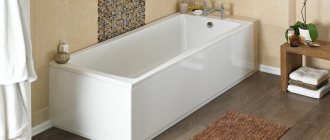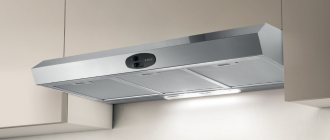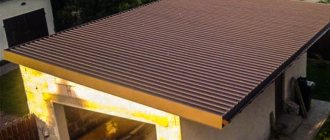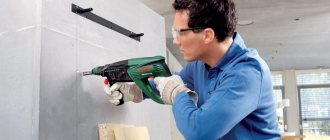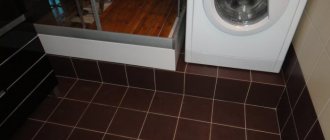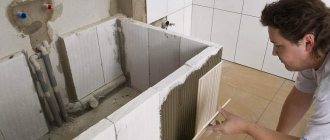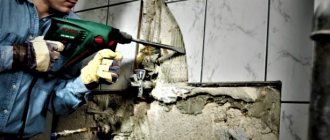Installing a decorative screen covering the space under the bathtub is the final stage of renovation of the room. There are many options for solving this problem: from hanging curtains to complex podium structures. Before closing the bathtub from below, you need to choose the optimal solution that will help you make good use of the space under the bowl.
How to cover the bottom of the bathtub: ready-made models
Bath screens have important functional and aesthetic significance. It can instantly create a convenient and stylistically designed storage space.
Purchasing a ready-made screen is a simple and practical solution. This is a common way to quickly and easily seal the space under your bathtub. The simple design consists of one or more panels made of moisture-resistant MDF, plastic or glass, mounted on a metal frame. The screen dimensions usually correspond to the dimensions of standard bathtubs, but it is also possible to make a custom-made screen according to your parameters. The legs of the bathtub screen are usually height-adjustable, allowing it to be installed sideways. If necessary, this panel can be easily removed.
The following models of ready-made screens are available:
Deaf
With sliding doors
With drawers
With hinged doors
Examples of each type of screen can be seen here.
Blind screens
This screen is a solid panel that completely covers the space between the bathtub and the floor. It is possible to remove it if necessary, but only entirely. Therefore, covering the bottom of the bathtub with blank panels is not a very good solution from the point of view of storage and operation.
Sliding screens
In a sliding screen, one, two or three panels are movably mounted on guides and can be moved behind each other. They are more convenient than solid models, as they can be used to close the bathtub below, while simultaneously providing quick access to communications and small items stored under the bathtub. At the same time, open doors do not take up extra space. Such screens are also easy to install yourself. Some models of this type are equipped with niches and shelves on which it is convenient to place essential household items.
Hinged screens with doors
This design differs from the previous one only in the way the doors are opened - they are fixed on hinges. Exactly how they open and close may not be very convenient in a small space.
Retractable screens with drawers
The most modern and not the most common option is models with smoothly sliding drawer compartments. With all the functional advantages, this method of sealing the space under the bathroom can be called much more expensive than those mentioned above. Installing such a screen on your own can also cause certain difficulties.
Materials for production
You can decorate your bathroom with panel panels yourself. Let's look at the main materials from which the screen can be made:
- plastic. It is simple and easy to install; not afraid of water and high humidity; may have different door configurations; wide color color; ease of cleaning; durability (can last up to 30 years); high level of strength;
- MDF. The material is moisture resistant, easy to maintain and clean; wide range, low cost. The disadvantages of the material include its short service life. In practice, this is no more than 5 years;
- mirror. The material is usually used by designers to decorate a room. This allows you to visually expand the space and make the room even larger. But glass: fragile; it needs to be constantly looked after, even minimal drops will be visible; expensive; difficult to install;
- glass. It looks beautiful, but turns out to be fragile. Tinted glass options are most often used.
Bath screen made of chipboard
To make the room even better than it is, it is recommended to provide a screen. If you additionally equip it with special niches and shelves, then you can place a lot of things under the bathtub. Not to mention that the screen can become a real highlight of the room's decoration.
Stationary structures
Stationary or permanent structures designed to completely cover the space under the bathroom. The choice of type of design depends on the material, construction skills and the availability of free space in the bathroom.
The basis of such structures is usually made from the following materials
- chipboard;
- moisture-resistant plasterboard;
- brick;
- board;
- plywood.
The finished base can be finished in any style - usually they are painted or tiled. Also common finishing methods are the use of film, mosaic, PVC panels or artificial stone. Decorating with wood is only possible if a moisture-resistant coating is used.
Brick options
This base will allow you to reliably and thoroughly close the niche under the bathtub. You can do it yourself at relatively low cost. The solid structure consists of half-brick brickwork with cement mortar, which guarantees strength and reliability. Cladding is also usually used, masking possible defects in the masonry by sealing them with one or several layers of tile adhesive.
MDF or plastic models
It is quite easy to cover the bathtub with panels that are attached to the frame at the top and bottom. It can also be made with your own hands, either from metal profiles or from wooden blocks treated with a special moisture-resistant compound.
First, according to the markings, the profile is installed from below
Then, every 60 cm, vertical supports are attached to it
The next stage is a profile or beam under the edge of the bathtub. Its level is fixed using guides screwed to the adjacent walls
The lower part of the frame is fixed with glue or sealant
If necessary, the profile is also fixed in the center of the future screen
It is important to provide a recess for the feet even at the frame stage, because the goal is not just to cover the bathtub with plastic from top to bottom, but also to provide ease of use, as well as the ability to quickly get to communications.
Panels of the required size are cut using an electric jigsaw
They also need to provide small ventilation slots.
You can connect several panels by inserting them into hollow plastic profiles like a locking system
The plastic structure is mounted on a finished frame using screws
Drywall
The general principle is the same as described above. However, when assembling the frame, it is worth considering the thickness of the final finish (for example, tiling). In bathrooms, only special plasterboard with a waterproof coating is used. When cutting sheets, subtract 2 cm from the desired screen height.
To prevent the canvas from swelling, it must be secured at a distance of 1 cm from the edge - best with self-tapping screws. After installation is completed, the material must be primed and sheathed with any material - tiles, film or decorative plaster. The gaps between the profile and the edge of the bathtub do not need to be sealed with sealant; construction foam can also be used.
How to work with a finished screen
Factory-made panels are equipped with fittings, fasteners and frames as needed.
If the dimensions of the structure correspond to the dimensions of the bathtub, then installation will not cause any difficulties.
To work you will need:
- screwdriver;
- roulette;
- building level or plumb line.
Before installing the screen, the bowl must be filled with water.
The installation steps do not depend on the shape and design of the product and are performed in the following sequence:
Measurements and markings. They are carried out to determine the installation locations of fasteners for fixing the frame. If necessary, panels are adjusted to the required dimensions.
- Frame installation. Carry out in accordance with the instructions using a building level. If the product has moving elements, then guides are additionally attached.
- Adjustment of support legs. By twisting them, they achieve maximum support of the frame against the side of the bowl. To prevent the supports from moving, the legs are fixed with sealant.
- Fastening the upper part of the frame. The junction of the frame and the bathtub canopy must be blown with foam to impart rigidity to the structure.
- Installation of panels. The blades of sliding devices are installed in the grooves of the guides, while those of hinged devices are hung on hinges. The fittings are screwed onto the doors.
- Sealing of seams. The joints must be sealed with sealant or any other available method to prevent water from getting under the bathtub.
Installing a plastic model will require the installation of additional supports to give the product rigidity.
Decorative curtain
The easiest and fastest way to cover the entire space, including the legs of the bathtub, is a decorative curtain. It masks everything unnecessary and at the same time makes it possible to get something out from under the bath at any time. In addition, the curtain is easy to maintain. You can sew it yourself by choosing a suitable material (its width should allow you to cover the bottom of the bathroom), or purchase a ready-made model. It is better to use polyester - this type of fabric leads in terms of practicality and moisture resistance.
You can secure the curtain, for example, using double-sided Velcro tape
On one side, the tape is fixed under the rim of the bathtub (most often with “liquid nails”)
On the other side the curtain fabric is attached
Another option is to install a narrow furniture pipe under the rim of the bathtub, having previously strung fastenings on it in the form of loops, on which the curtain will be held.
Curtain under the bath
It is important to note that this simple and practical option for decorating the space under the bathroom is not suitable for all interior styles. So, it will look good as a variation of country style and look extremely unprofitable in a bathroom with an ultra-modern design.
Tips and tricks for arrangement
In a small room, every corner needs to be used. The door can be converted into a hanger for towels and clothes. It is enough to screw the hooks or crossbar to it. You can even attach a small shelf for small items. It is advisable to choose a sink with a bedside table where cleaning products, rags, sponges and other things will be stored. If this is not possible, it is recommended to buy a basket where you can store household chemicals or put dirty things. The space under the sink should be used to the maximum because it is functional and adds coziness to the room. All bathroom cabinets should have 2 or 3 tiers to save space. The wall above the toilet, as a rule, is not used in any way, since there is a risk of hitting your head on objects.
However, you can attach a small shelf to it for storing cosmetics, towels and toilet paper. It’s convenient to hang towels on hooks in the wall, so they don’t take up much space and are easy to take. However, if there is no space on the walls, you can use baskets and racks. Towels easily fold into “rolls” and other shapes. You can make a beautiful composition out of them. This arrangement saves a lot of space. Every home has things that are used very rarely: spare towels, household cleaning chemicals, a first aid kit, etc. You can store them on high shelves when there is no more space left on the floor and walls. They will not clutter up the space, and storage will become more convenient.
A mirror in the bathroom is an important attribute. In stores you can find models with opening shelves. The mirror plays the role of a door. Inside you can place cosmetics and household chemicals. A good solution would be to screw shelves on the sides of the mirror. To prevent cosmetics from lying everywhere, it is best to purchase an organizer or make one yourself. You can place shelves in the corner of the room. They won’t fit many items, but it’s better to add several levels for greater functionality. Placing furniture in the bathroom can be challenging due to the small space. Periodically, it is worth doing general cleaning and throwing away unnecessary things.
Bath podium
An elegant solution for spacious bathrooms. Here you are limited only by your own imagination. Like most blind stationary structures, the base of the podium covers the entire distance between the bathtub and the floor. It is laid out from bricks or blocks and finished with mosaics or tiles. The steps are covered with an anti-slip compound.
According to its design, a bathroom podium can be monolithic or frame. The first option involves one small step. The undoubted advantages of the monolith are its reliability and strength, as well as moisture resistance. But like all blind structures, it blocks access to communications.
To create a monolithic podium, formwork that is not adjacent to the walls is laid along the outer perimeter of the future structure. If the bathtub is installed, the drain is installed and all communications are in working order, the interior space is filled with concrete. The masonry mesh is slightly recessed on top. After the structure has hardened, you can proceed to finishing work.
The frame podium is hollow inside - it can be used for storage. The metal profile is additionally reinforced with wooden beams to impart rigidity to the structure. For the construction of steps, additional intermediate logs are used. The finished frame is covered with plywood or plasterboard and decorated.
Final stage
Lastly, the plumbing fixtures are installed and the podium surface is tiled. The tiles do not harm the environment, they are hygienic and easy to care for. Lay the tiles on brickwork or plasterboard screen. At this stage, the plane is regularly checked with a level, crosses are placed at the joints, so that the seams are of the same thickness.
When the glue dries, the joints are filled with fugue to increase water resistance. To prevent water from entering the structure, the gap between the bathtub and the podium along the perimeter is sealed with silicone sealant. Excess of this substance is carefully removed.
About installing a drawer
To ensure that the structure fits easily into the body, it is made two centimeters narrower. You can't do without guides. Some are equipped with simple roller samboxes and tandemboxes (the system is more advanced and has a self-closer). The fittings will not be noticeable and there will be no need to process their ends if the sides are placed between the front and back walls. The bottom of the box is made of fiberboard. The fragments are connected with nails (20 mm). For reinforcement, you can use 1.6 x 0.4 cm self-tapping screws.
